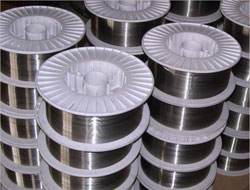
Trade promotes production, production furthers trade
Mission: To be abundant in China, to be beneficial everywhere
Business philosophy: Survive by quality, develop on creativity
Dream: Struggle for astronautics of humankind
Service philosophy: Is it not delightful to have friends coming from afar



|
product |
Grade |
Standard |
State |
Diameter(mm) |
|
Nickel |
NO2200 |
ASTM B164 |
hard(Y) |
0.2-6.0 |
Nickel is a chemical element with the chemical symbol Ni and atomic number 28. It is a silvery-white lustrous metal with a slight golden tinge. Nickel belongs to the transition metals and is hard and ductile. Pure nickel shows a significant chemical activity that can be observed when nickel is powdered to maximize the exposed surface area on which reactions can occur, but larger pieces of the metal are slow to react with air at ambient conditions due to the formation of a protective oxide surface. Even then, nickel is reactive enough with oxygen that native nickel is rarely found on Earth's surface, being mostly confined to the interiors of larger nickel–iron meteorites that were protected from oxidation during their time in space. On Earth, such native nickel is always found in combination with iron, a reflection of those elements' origin as major end products of supernova nucleosynthesis. An iron–nickel mixture is thought to compose Earth's inner core.
The use of nickel (as a natural meteoric nickel–iron alloy) has been traced as far back as 3500 BC. Nickel was first isolated and classified as a chemical element in 1751 by Axel Fredrik Cronstedt, who initially mistook its ore for a copper mineral. The element's name comes from a mischievous sprite of German miner mythology, Nickel (similar to Old Nick), that personified the fact that copper-nickel ores resisted refinement into copper. An economically important source of nickel is the iron ore limonite, which often contains 1-2% nickel. Nickel's other important ore minerals include garnierite, and pentlandite. Major production sites include the Sudbury region in Canada (which is thought to be of meteoric origin), New Caledonia in the Pacific, and Norilsk in Russia.
Because of nickel's slow rate of oxidation at room temperature, it is considered corrosion-resistant. Historically, this has led to its use for plating metals such as iron and brass, in chemical apparatus, and in certain alloys that retain a high silvery polish, such as German silver. About 6% of world nickel production is still used for corrosion-resistant pure-nickel plating. Nickel was once a common component ofcoins, but has largely been replaced by cheaper iron for this purpose, especially since the metal is a skinallergen for some people. It was reintroduced into UK coins in 2012 despite objections from dermatologists.
Nickel is one of four elements that are ferromagnetic around room temperature. Alnico permanent magnets based partly on nickel are of intermediate strength between iron-based permanent magnets and rare-earth magnets. The metal is chiefly valuable in the modern world for the alloys it forms; about 60% of world production is used in nickel-steels (particularly stainless steel). Other common alloys, as well as some new superalloys, make up most of the remainder of world nickel use, with chemical uses for nickel compounds consuming less than 3% of production. As a compound, nickel has a number of niche chemical manufacturing uses, such as acatalyst for hydrogenation. Enzymes of some microorganisms and plants contain nickel as an active site, which makes the metal an essential nutrient for them.
Characteristics
Atomic and physical properties
Nickel is a silvery-white metal with a slight golden tinge that takes a high polish. It is one of only four elements that are magnetic at or near room temperature, the others being iron, cobalt and gadolinium. Its Curie temperature is 355 °C, meaning that bulk nickel is non-magnetic above this temperature. The unit cell of nickel is a face centered cube with the lattice parameter of 0.352 nm giving an atomic radius of 0.124 nm. Nickel belongs to the transition metals and is hard and ductile.
please
Call: +86-(0)917-3565328
No.195 Gaoxin Road
Titinum Valley Building
Baoji Hi-tech Zone
Shaanxi province, China
